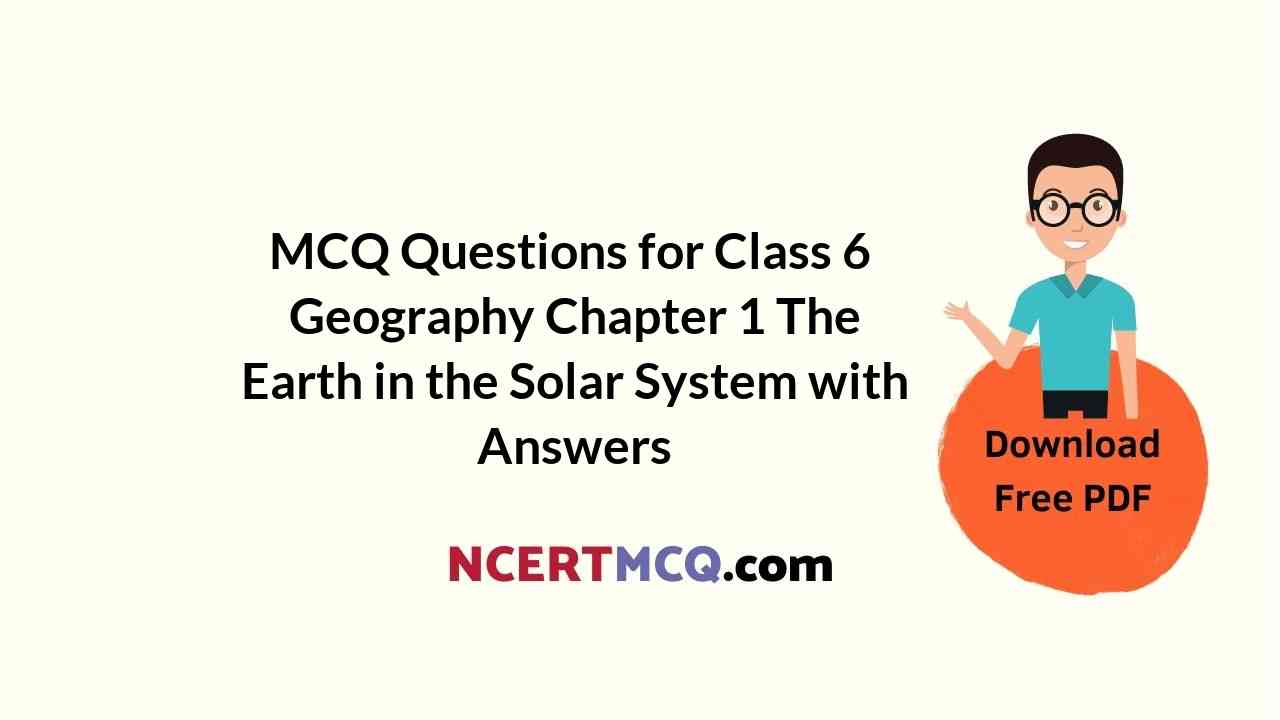Check the below NCERT MCQ Questions for Class 6 Geography Chapter 1 The Earth in the Solar System with Answers Pdf free download. MCQ Questions for Class 6 Social Science with Answers were prepared based on the latest exam pattern. We have Provided The Earth in the Solar System Class 6 Geography MCQs Questions with Answers to help students understand the concept very well.
Class 6 Social Science Geography Chapter 1 MCQ With Answers
Geography Class 6 Chapter 1 MCQs On The Earth in the Solar System
Choose the correct answer:
Class 6 Geography Chapter 1 MCQ Question 1.
How is the sky filled with after sunset and in the night?
(a) Bright objects
(b) Dim objects
(c) Both (a) and (b)
(d) None of these
Answer
Answer: (c) Both (a) and (b)
MCQ Questions For Class 6 Geography Chapter 1 Question 2.
What is the name given to the full moon night?
(a) Amavasya
(b) Poornima
(c) Both (a) and (b)
(d) None of these
Answer
Answer: (b) Poornima
The Earth In The Solar System Class 6 MCQ Question 3.
Which of the following name is given to the new moon?
(a) Poornima
(b) Amavasya
(c) Both (a) and ib)
(d) None of these
Answer
Answer: (b) Amavasya
Ncert Class 6 Geography Chapter 1 MCQ Question 4.
What are celestial bodies?
(a) The sun
(b) The moon
(c) All the shining bodies in the sky
(d) All of these
Answer
Answer: (d) All of these
The Earth In The Solar System MCQ Question 5.
The celestial bodies which have their own heat and light are called
(a) planets
(b) stars
(c) satellites
(d) all of these
Answer
Answer: (b) stars
Class 6th Geography Chapter 1 MCQ Question 6.
Which is the most recognisable constellation?
(a) The saptarishi
(b) The moon
(c) The sun
(d) The mars
Answer
Answer: (a) The saptarishi
Geography Class 6 Chapter 1 MCQ Question 7.
The star which indicates the north is called
(a) pole star
(b) pole
(c) north pole
(d) south pole
Answer
Answer: (a) pole star
The Earth In The Solar System Class 6 MCQ With Answers Question 8.
The celestial bodies which do not have their own heat and light but are lit by the light of the stars are named as
(a) stars
(b) planets
(c) both (a) and (b)
(d) none of these
Answer
Answer: (b) planets
Class 6 Chapter 1 Geography MCQ Question 9.
The word ‘planet’ has been derived from the word ‘planetai’ which is named as
(a) Latin word
(b) German word
(c) Greek word
(d) English word
Answer
Answer: (c) Greek word
MCQ Class 6 Geography Chapter 1 Question 10.
Which celestial bodies form the solar system?
(a) The sun
(b) The planets
(c) The satellites, asteroids and meteoroids
(d) All of the above
Answer
Answer: (d) All of the above
Class 6 Geography Ch 1 MCQ Question 11.
All the planets move around the sun in fixed elliptical path, these paths are called
(a) axis
(b) orbit
(e) both (a) and (b)
(d) none of these
Answer
Answer: (b) orbit
Geography Chapter 1 Class 6 MCQ Question 12.
Why is the shape of the earth geoid?
(a) It is slightly flattened at the poles
(b) It is spheroid at the poles
(c) Both (a) and (b)
(d) None of these
Answer
Answer: (a) It is slightly flattened at the poles
Class 6 Geography Chapter 1 MCQ Questions And Answers Question 13.
The earth is called a unique planet due to
(a) neither too hot nor too cold
(b) presence of air and water
(c) oxygen, light supporting gas
(d) all of these
Answer
Answer: (d) all of these
Class 6 Sst Geography Chapter 1 MCQ Question 14.
The earth is called a blue planet because of the presence of
(a) water
(b) blue colour
(c) brown colour
(d) red colour
Answer
Answer: (a) water
Earth In The Solar System Class 6 MCQ Question 15.
Why do we see only one side of the moon from the earth?
(a) Because of moon moving around the earth in 27 days
(b) 27 days also taken in one spin
(c) Both (a) and (b)
(d) None of these
Answer
Answer: (c) Both (a) and (b)
MCQ Questions For Class 6 Social Science Geography Chapter 1 Question 16.
Why does the moon not have conditions favourable for life?
(a) because of non existent of water
(b) because of non existent of air
(c) both (a) and (b)
(d) none of these
Answer
Answer: (c) both (a) and (b)
Class 6 Geography MCQ Question 17.
Apart from stars, planets and satellites, there are numerous bodies which also move around the sun, what are these called?
(a) Stars
(b) Asteroids
(c) Meteoroids
(d) Planets
Answer
Answer: (c) Meteoroids
Chapter 1 Geography Class 6 MCQ Question 18.
Asteroids are found between the orbits of Jupiter and
(a) Mars
(b) Earth
(c) Venus
(d) Neptune
Answer
Answer: (a) Mars
Geography Chapter 1 MCQ Class 6 Question 19.
Meteoroids are made up of
(a) dust
(b) pieces of rocks
(c) gases
(d) none of these
Answer
Answer: (b) pieces of rocks
Class 6 Geography Chapter 1 MCQs Question 20.
What is called a cluster of millions of stars, shining white in the starry sky?
(a) Stars
(b) Planets
(c) Milky Way galaxy
(d) Satellites
Answer
Answer: (c) Milky Way galaxy
Question 21.
What makes the universe?
(a) Millions of galaxies
(b) Millions of stars
(c) Earth
(d) Satellites
Answer
Answer: (a) Millions of galaxies
We hope the given NCERT MCQ Questions for Class 6 Geography Chapter 1 The Earth in the Solar System with Answers Pdf free download will help you. If you have any queries regarding The Earth in the Solar System CBSE Class 6 Geography MCQs Multiple Choice Questions with Answers, drop a comment below and we will get back to you soon.
Class 6 Social Science Geography MCQ:
